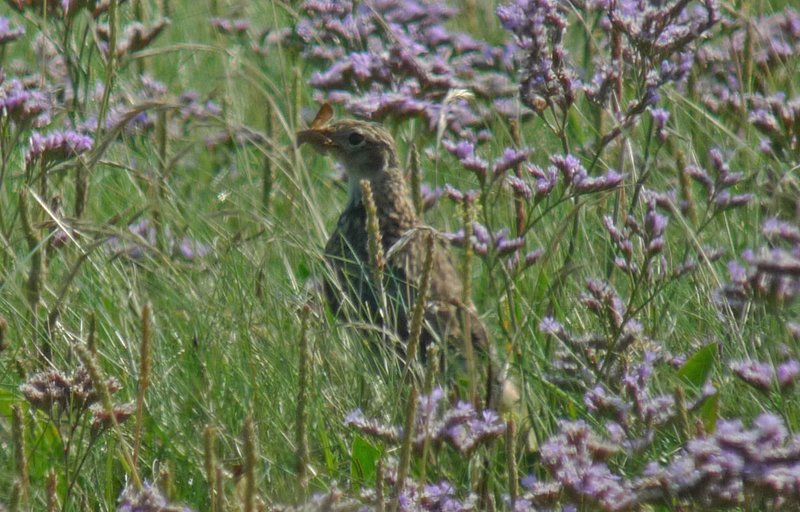Veldleeuwerik
Alauda arvensis · Eurasian Skylark
 Veldleeuwerik ·
Alauda arvensis
·
14-08-2010 · Marc Plomp
Veldleeuwerik ·
Alauda arvensis
·
14-08-2010 · Marc Plomp
| Datum | 14 August 2010 |
|---|---|
| Locatie | De Slufter, Texel |
| Fotograaf |
|
| Bekeken | 12859 × |
| Foto gemaakt door Nicolas Hoffmann uit Frankrijk. En ja hoor, hier de volgende die we mislopen????. Deze foto kreeg ik via ons vogelinformatiecentrum gisteren binnen van de Fransman die ook de Aziatische Goudplevier heeft ontdekt. Dit is wat hij in de mail schreef: I also wanted to inform you of another sighting of a rare bird on the island that I made on August 14 at approximately 11:10 in "De Slufter", right here: google map Attached is the only photo of the bird that I could take. Context...: I first heard an unusual song and then I found a great "lark" who crossed the road in flight and landed in the middle of statice. I had occasion to correctly observe it because when it moving it regularly appeared discovered, "congealing" sometimes with drawing the head. So far I have had the opportunity to note the criteria for identifying specific Melanocorypha calandra (Calandra Lark) including: - Large black spots along the chest - The calotte was clear, not blocked as that of the skylark, and no sharp contrast between the shell and the rest of the head. - Ditto for the neck. - Tooth, although he appeared rather late in the picture was quite long and thick, in any case much more than the skylark. All these visual criteria associated with the cry and the size of the bird leaves me no doubt about the identification. The only possible confusion concerns the skylark, but I know this widespread species at home in Alsace. I also had occasion to observe the Calandra lark before. Sorry to report this information so late, she remained huddled in a corner of my memory ... Graag jullie mening over de foto en determinatie, maar ik en bang dat we gewoon wat pech hebben. |
Discussie
Arnold Meijer
·
25 August 2010 22:05
Vincent Hart
·
25 August 2010 22:10
Marc Plomp
·
25 August 2010 22:12
Luuk Punt
·
25 August 2010 22:14
Michel Veldt
·
25 August 2010 22:17
Hans Schekkerman
·
25 August 2010 22:28
Marc Plomp
·
25 August 2010 22:30
Arnold Meijer
·
25 August 2010 22:38
Hans ter Haar († 2011)
·
25 August 2010 22:46
Ruud Brouwer
·
25 August 2010 22:47
Nils van Duivendijk
·
25 August 2010 22:48
Maarten Hotting
·
25 August 2010 22:51, gewijzigd 25 August 2010 22:56
Wietze Janse
·
25 August 2010 22:56
Albert de Jong
·
25 August 2010 23:10
Frank Neijts
·
25 August 2010 23:14
Fred Visscher
·
26 August 2010 08:04
Menno van Duijn
·
26 August 2010 09:05
Jelle Scharringa
·
26 August 2010 12:44
Edwin Russer
·
26 August 2010 13:22
Arnold Meijer
·
26 August 2010 14:57
Ronald Messemaker
·
26 August 2010 15:22
René van Rossum
·
26 August 2010 19:14
Marc Plomp
·
26 August 2010 21:52
Ronald Messemaker
·
27 August 2010 10:33
George Sangster
·
23 May 2023 21:31, gewijzigd 23 May 2023 21:37
Rigal, S et al 2023. Farmland practices are driving bird population decline across Europe. PNAS 120 (21): e2216573120
Abstract: Declines in European bird populations are reported for decades but the direct effect of major anthropogenic pressures on such declines remains unquantified. Causal relationships between pressures and bird population responses are difficult to identify as pressures interact at different spatial scales and responses vary among species. Here, we uncover direct relationships between population time-series of 170 common bird species, monitored at more than 20,000 sites in 28 European countries, over 37 y, and four widespread anthropogenic pressures: agricultural intensification, change in forest cover, urbanisation and temperature change over the last decades. We quantify the influence of each pressure on population time-series and its importance relative to other pressures, and we identify traits of most affected species. We find that agricultural intensification, in particular pesticides and fertiliser use, is the main pressure for most bird population declines, especially for invertebrate feeders. Responses to changes in forest cover, urbanisation and temperature are more species-specific. Specifically, forest cover is associated with a positive effect and growing urbanisation with a negative effect on population dynamics, while temperature change has an effect on the dynamics of a large number of bird populations, the magnitude and direction of which depend on species' thermal preferences. Our results not only confirm the pervasive and strong effects of anthropogenic pressures on common breeding birds, but quantify the relative strength of these effects stressing the urgent need for transformative changes in the way of inhabiting the world in European countries, if bird populations shall have a chance of recovering.
Significance: Using the most recent and largest empirical dataset ever assembled for Europe to investigate the effect of anthropogenic pressures, we highlighted the predominant detrimental impact of agriculture intensification on avian biodiversity at a continental scale over climate change, urbanization, and forest cover changes. Our results do not simply quantify correlations, but our analytical design is meant to strive for more quasicausal responses of bird populations to global change drivers. This paper contributes to the highest political and technical challenge faced by agricultural policy in Europe, struggling to balance high productivity from intensive agricultural practices with environmental protection, and the results are therefore crucial to policymakers, scientists, and the general public concerned for biodiversity and global change issues.
George Sangster
·
3 June 2023 19:53
Eenvoudiger geschreven samenvatting van bovenstaand artikel.
Gebruikers van het forum gaan akkoord met de forumregels.
